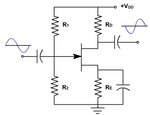skatefast08
Full Member level 3
I need to calculate the gate current (Igs) using an ATF 54143 transistor for a common source amplifier, because I need to make sure Igs < 1mA. the common source amp has R1 (connected to power supply), R2 (connected to ground), Rd, and Rs. Im trying to figure out the best bias design for a 2.4 GHz microwave amplifier, using this layout form:

[from nptel.ac.in /courses /117107095 /lecturers /lecture_39 /images /fig20.jpg]
In order to get best bias, I think I would need to get close to 1mA for Igs, so I could use the lowest bias resistance (which would decrease noise also).
Vds = 3V, Id = 30mA, Vgs = 0.6V, Vdd = 5v, and need to make sure Igs < 1mA
ATF 54143 datasheet is right here: **broken link removed**
Thanks

[from nptel.ac.in /courses /117107095 /lecturers /lecture_39 /images /fig20.jpg]
In order to get best bias, I think I would need to get close to 1mA for Igs, so I could use the lowest bias resistance (which would decrease noise also).
Vds = 3V, Id = 30mA, Vgs = 0.6V, Vdd = 5v, and need to make sure Igs < 1mA
ATF 54143 datasheet is right here: **broken link removed**
Thanks